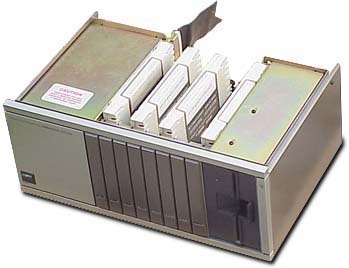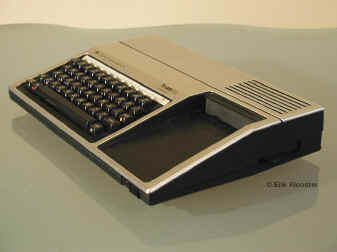
HISTORY OF HOME AND GAME COMPUTERS

| Navigator | ||||||||||||||||||
|
|
|
|
||||||||||||||||
|
|
||||||||||||||||||
Differences between the 99/4 and 99/4ABetween the TI 99/4 and the TI 99/4A were some striking and less striking differences: - The keyboard of the 4A was better and greater. De 4 had keys like those of a calculator. The most striking difference are the orange ENTER- and SHIFT-keys on the 4. - The smaller number of keys on the 4 could lead to some risky situations. For instance, the 4 didn't have a FUNC-key. A program could be stopped with SHIFT-C. Who instead of that pressed SHIFT-Q, lost everything, because this was the fatal reset combination. - On the 4, you could only type in capitals. - Unlike the 4A, the 4 had overlays that covered the whole keyboard. - In the start menu the 4 had an extra option: the calculator function. This explains why the 4 had 5 KB more ROM. - The 4 had a different graphic chip, with an extra mode, although one could not use it in BASIC. - The adapters were different - never confuse them!
|
Welcome to the nostalgic
history of home and game computers
![]()
TEXAS INSTRUMENTS TI 99/4A-
TI's short-lived adventure
|
For me it was the beginning of an addiction to countless games like TI Invaders, but also the beginning of a long exploration of all the possibilities of BASIC. |
Elegant
The Texas Instruments 99/4A was the successor of the TI
99/4, which because
of it's late introduction in Europe only led a short life there. The case
was just as elegant as that of the 99/4 - aluminium and black plastic -
but some aspects were improved. The 99/4a had a mature keyboard, a major
improvement compared with the (only) 41 calculator-like keys of the 99/4.
More differences between the two computers are described in the box
elsewhere on this page.
In other respects these home computers also showed great promise. For instance, they were equipped with an excellent graphic chip, known from the Colecovision and of course also manufactured by Texas Instruments. This chip conjured up sixteen colours on the screen and made it possible to use sprites. |
Cartridges
The TI 99/4 and 99/4A had a cartridge slot that simply asked to be used. A
tape recorder in combination with these computers, somehow or other was
'not done'. Texas Instruments and some other companies produced dozens of
different cartridges, varying from games to administrative programs.
Options |
 |
When you had all those options,
you had a snake of devices connected to your computer. Texas Instruments
was aware of this problem and started to sell in 1982 the so-called
Peripheral Expansion Box. This box was equipped with a floppy drive and a
memory extension and had besides that six slots to hide other options in
an orderly way. With this large box you had almost a real PC at home.
Beige model
Besides, Texas Instruments initially asked a substantially prices for the
computers, and the options were also expensive. Soon a price ware flared
up with Commodore and other companies. Texas Instruments tried to survive
on the home computer market with a beige model of the TI 99/4A that was
cheaper to manufacture, but it was of no avail. Finally TI went below the
cost price, and the company was in the red.
TI was through with it
At the end of 1983 Texas Instruments decided to quit
the home computer market. Then, some 2.5 million 4A computers were sold.
It is to its credit that Texas Instruments during a long time maintained
the service for owners of its home computers.
Specifications of the Texas Instruments TI 99/4A
| Manufacturer | Texas Instruments |
| Period | 1981 - 1984 |
| CPU | TMS 9900A |
| Frequency | 3,3 MHz |
| ROM | 26 KB |
| RAM | 16,25 KB |
| Text mode | 32 x 24 (16 colours), 40 x 24 (2 colours) |
| Graphic mode | 256 x 192 |
| Colours | 16 |
| Sound | 3 channels, 5 octaves, 1 noise |
| I/O | monitor, cassette, cartridge, 2x joystick, extension port |
| Price | 525 U.S. dollar |
| News | |||
|
|
|
|
|
|
|
|||
View results from last poll:
how many games you have? (3127
votes)




